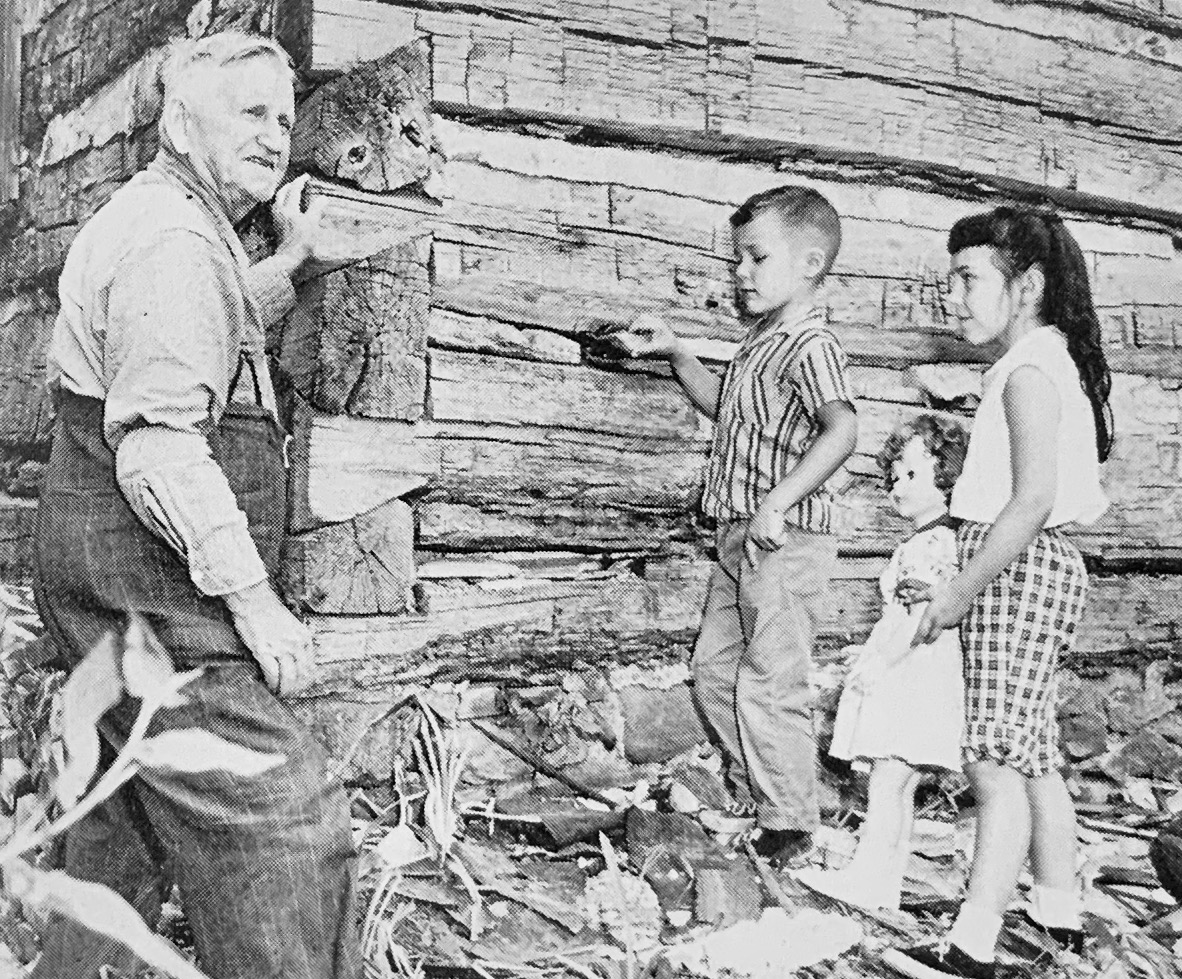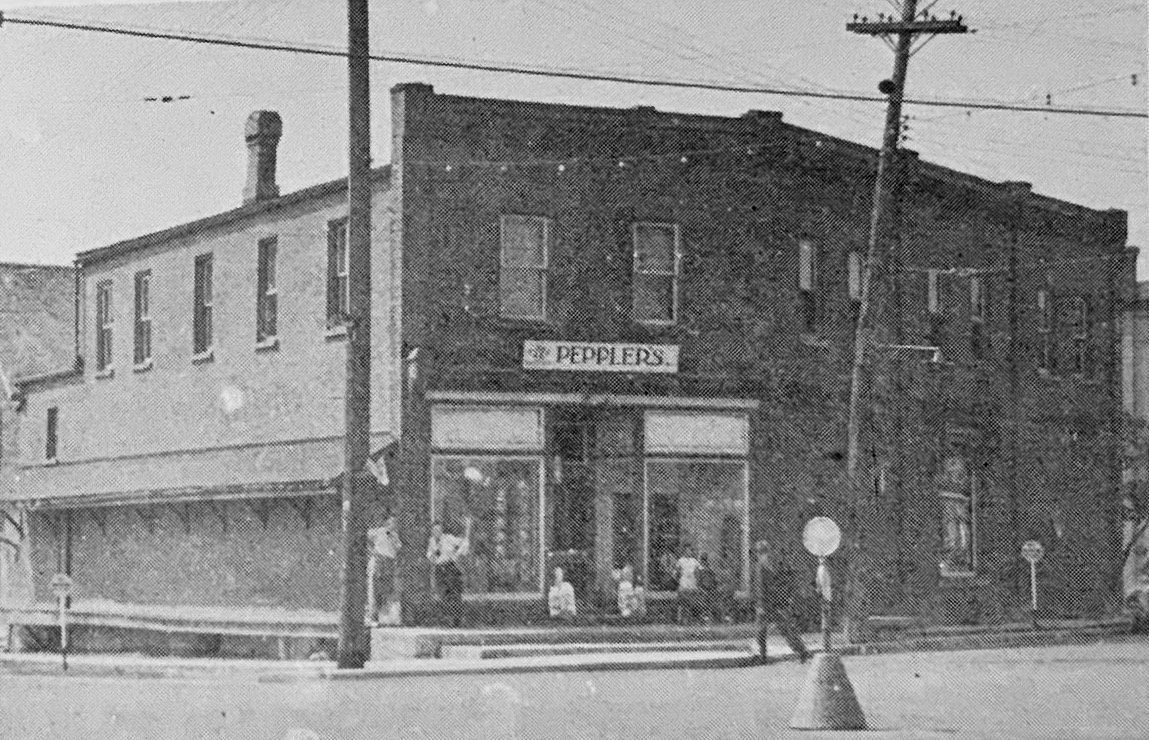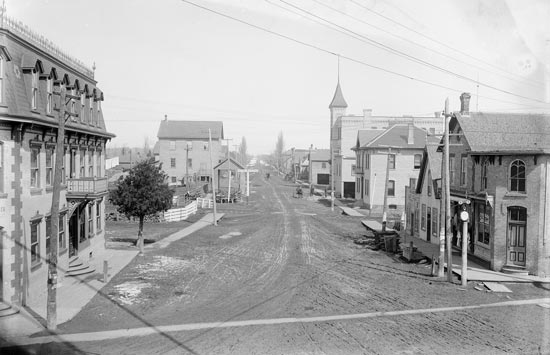| Fact & Fantasy: A History of Tavistock & District | Vanishing Landmarks - Page 170-176 |
|
|
VANISHING LANDMARKS
"Nothing is permanent but change." This axiom is likewise true of ordinary homes in Tavistock but more so of buildings that once were considered as stable landmarks without which the village would cease to exist. August Matthies' Log House - Hope Street E.This old house was removed from the property of Dr. George Burton. It housed until recently the repair shop of Edgar Vogt, who has purchased the former Arthur Ford home on Minerva St. Prior to this in the time when we were kids, the property was fenced in by a high cedar hedge, which ran close to the sidewalk all the way to the next white frame house that belonged to Les and Mrs. Harris, the parents of Laurie Harris, who distinguished himself as a hockey player. The picture shows Mr. Jacob Kipfer from across the road, explaining the nature of things to his great grandson Wayne Gascho, and his little playmate Doris Anne Seltzer. The house was carefully dismantled and re-assembled by Mr. Smith at Port Stanley July 25, 1962.  Old Log Cabin
Old Log CabinThe corner, between Maria and Woodstock St. S. has been so termed locally. It seems that under the Diefenbaker regime our village had been promised a post-office, but in the change of government, that project ended with the clearing of the building, since Wally Nesbitt, the member for Oxford, belonged to the party out of power. As a parking lot it has proved an asset to our Village, for we already have a fine post-office. The Peppler Block, formerly owned by Valentine Stock, was a large, two-storey red brick building with a platform running the length of the east side. where barrels of salt used to be stored. Behind the building were a shed and a barn, where cement was kept and chickens used to be processed, which had been taken in exchange for goods. Here too, barrels of apple "schnitz" were stamped tight for the Prairie Provinces. When the Rev. Krotz came to Tavistock to take over his E.U.B . charge, he dropped in to Peppler's store to report some of the barrels had returned to Tavistock , packed with his family effects. Mr. Stock had acquired the business from John Klein. He had added to its clap-board structure, not only the brick exterior, but had enlarged it to more than twice its size, southward along Woodstock Street. The building had been bought, at the time of its razing in 1958, from B.C. Ratz, who had acquired it from the Peppler Estate in 1948. It had stood vacant during those ten years. (The red brick building was demolished in October of 1963 and became a parking lot nicknamed "Pearson's Plaza". The new post office was built on the site and opened on November 30, 1970.)  PEPPLER'S at the corner of Woodstock and Maria St. S.
PEPPLER'S at the corner of Woodstock and Maria St. S.All that remains of this fine structure in 1967 is a portion of the north wall. It is a hundred years old, for in 1866, on this site, George Malcolm erected a four-storey flouring and grist mill at a cost of $7,000. According to the New Hamburg Independent of August 21, 1878, Mr. Malcolm was still one of Tavistock's leading business men, with Klein, Kalbfleisch & Co., running him opposition down on Maria Street. His firm was known as the Tavistock Mills. It was made of red brick, 40 feet square, with an engine house 20x40 feet. The engine was one of 60 horsepower, sufficient to drive the four runs of stones. 
Left: Commercial Hotel, oak sidewalk to G.T.R. Station, weigh-scales (burned May 24, 1900), The Tavistock Mills (note the peaked roof and 3 sets of windows). Right: M.M. Staebler's Jewelry Store, G.G. Peppler's Store, Sam Zehr, barber, J.W. Ratz, tinsmith, - made into one block by W.E. Ratz, sold to M..M. Staebler, then to August Schaefer, Jan. 17, 1901. Bauer's Hotel and barn, The Arlington Hotel - built 1895. In the issue of the Gazette, May 24, 1900, The Foresters' Hall had been taken over by John Kalbfleisch. Extensive alterations, and an addition were made to the rear, 75x38 feet. Later that year Mr. J.W. Ratz moved his tinsmithing business from a small shop, two doors north of the old Peppler Store, to the second floor of Mr. Kalbfleisch's building. Mr. August Schaefer moved his feed and seed store to the south side and Adam Diehl opened his liquor store on the north side. The November 29 issue reports the brick work completed by Jacob Seltzer, and the roof being removed from the old part to make it uniform with the new. This now provided two fine meeting halls, the smaller one, called the Society Hall, on the second floor behind J.W. Ratz's, and the larger hall with sloping floor on the third storey, the Opera Hall. Here some famous actors and companies came to perform, here local and district talent put on their concerts and musicals. The old drop-curtain with its peep-holes bore the names of many. Here the "movie" had their Tavistock premiere, here the Y-Minstrels of Woodstock Y.M.C.A. cracked their jokes, here the graduates were honoured at Commencements. It had in its century of service housed many industries: the Chinese laundry of Wong Foo; the repair shop of Fred Schliuse; the implement agencies of T.A. Jickling and of J.W. Lingelbach; the broom factory of Charles and William Hanke, who imported their broom-corn from Decatur, Illinois and bleached it with burning sulphur to whiten their brooms; the Tavistock Gazette and the Tavistock Produce. It assumed the name of Horman' Hall when Mr. Wm. Horman purchased it. Mr. G.K. Brown, the owner-publisher of The Gazette, bought it and his estate turned it over to the village after his death. For some years, it stood vacant but in the spring of 1967 the Village Council sold the property to the owners of the Arlington Motel for $200. (TG: April 5, 1967: Familiar Landmark, Opera Hall Block, Now in Course of Being Demolished). It now serves as a parking lot. |
|
|
| PREVIOUS | TABLE OF CONTENTS | NEXT |